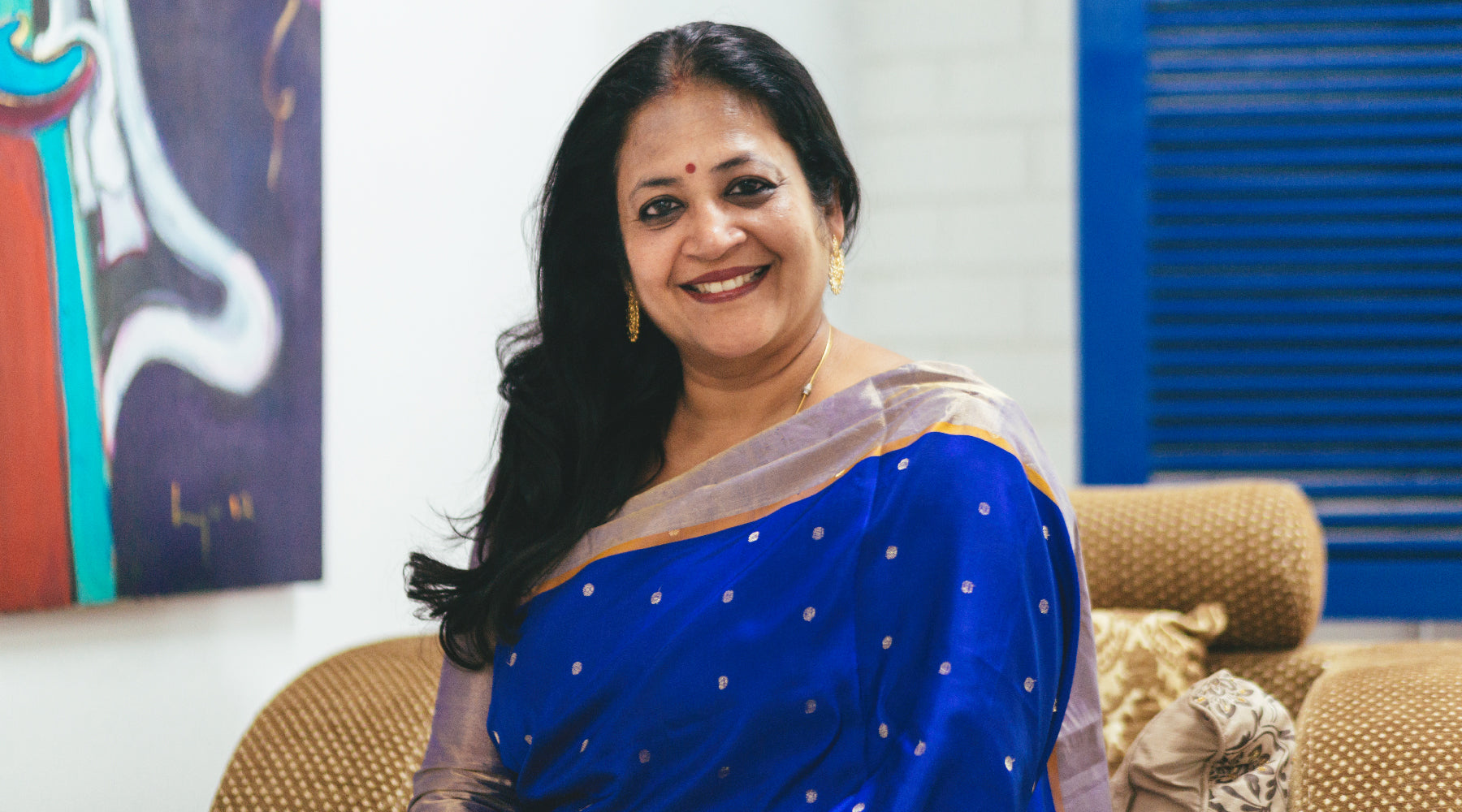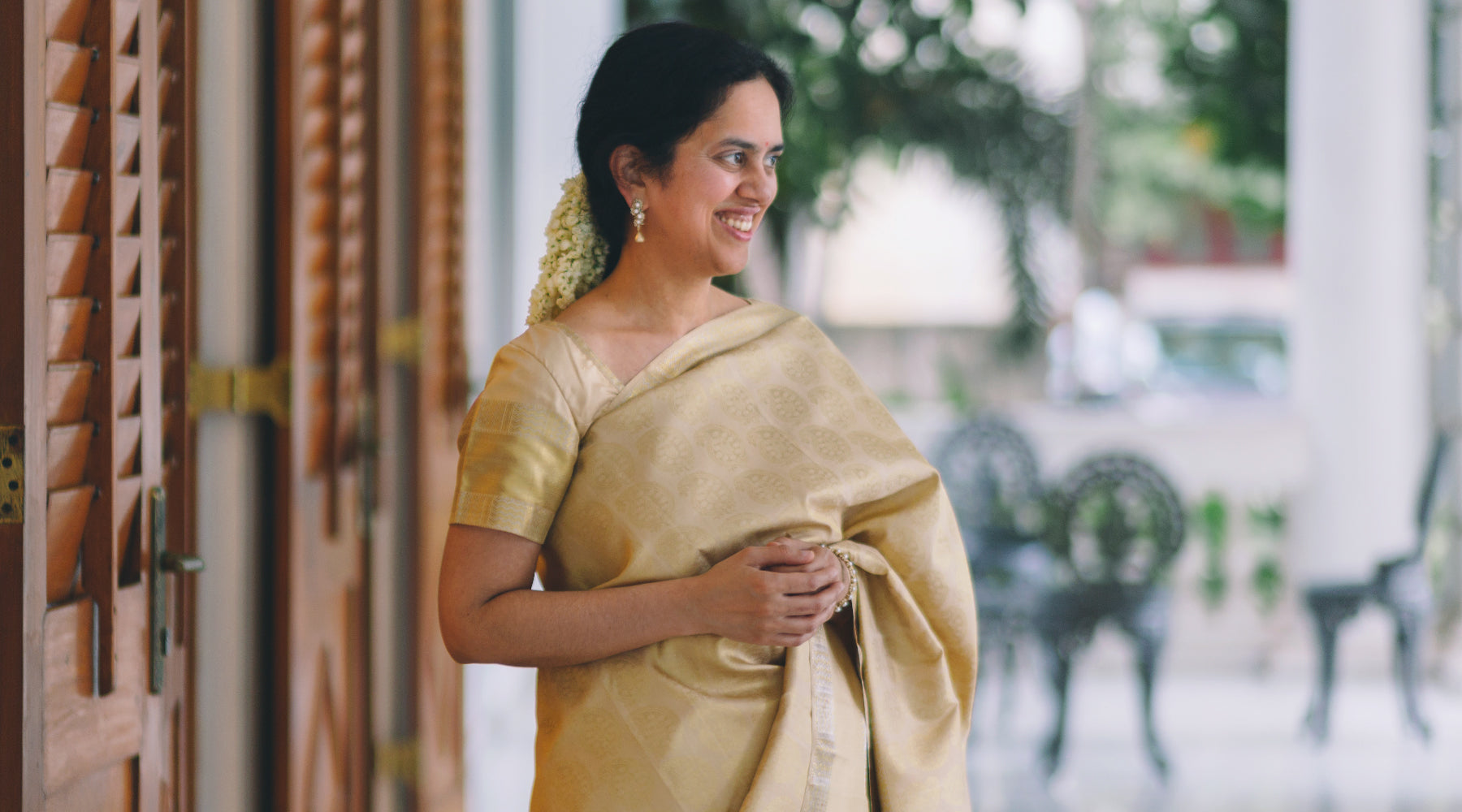KANAKAVALLI VIGNETTES : Priya Murle - Dance, Dance, Dance

Priya Murle is a dancer, first and foremost. But she is also a choreographer, a teacher and a writer, who is passionate about music and has keen academic interests in aesthetics and culture. Her vibrant, multifaceted personality feeds in to her multidimensional approach to the classical arts.
In the March edition of Vignettes, Priya talks to Aneesha Bangera of the Kanakavalli Journal, taking us back to where it all began. She reminisces about growing up in a home where everything revolved around music and dance, and remembers the excitement of wearing her very first sari.
Priya contemplates the definition of tradition; for her, being traditional is synonymous with being dynamic, broad-minded, all-encompassing. The sari has been in integral part of Priya’s identity, and the centrality of the drape in her life is reflected in her curation of exquisite kanjivarams from www.kanakavalli.com. Excerpts of the conversation below…
Dance, Dance, Dance
You come from a family that is passionate about culture, while having a strong academic bent of mind. Can you trace your journey from these roots to who you are today?
As a young girl in Bombay in the 1940s, my mother learnt classical dance. When she got married and had children, she decided she would have a daughter who would be a dancer. We were three siblings; I’m the youngest and the only girl. So, I don’t think I had much of a choice, but fortunately, I was always inclined toward the arts. As soon as I was old enough, I was sent to lessons nearby, and went on to become a disciple of Professor Sudharani Raghupathy, with whom I have danced for over forty years. On my father’s side, my aunt Seethalakshmi Venkatesan was a revered Carnatic singer and teacher; she enjoyed a close bond with M S Subbulakshmi, and was, in fact, called the MS of Bangalore. My brothers were also very musically inclined; the elder, Mahesh, learnt the sitar and guitar, and Srikanth learnt the mridangam and drums. They had a Western band – The Versatiles – as well as an Indian troupe, and would often perform. My paternal grandfather had been a professor of English in Trivandrum, and had been published. I had many cousins who had obtained PhDs, and I was also interested in academic pursuits. If you’re good at the arts, I think you’ll also be proficient academically – the orientation and the focus you need to study come naturally if you practice an art form. So, on the one hand, I had started imbibing a love for the arts from the moment I was born, and on the other, I was surrounded by questioning and curious academic minds. This was my background. I might not have had a choice when it all began, but it was a happy choice, and one that transformed my life.
Could you share with us some of your earliest memories of Bharatanatyam dance from your childhood?
I have so many memories not only of Bharatanatyam, but of all forms of classical dance and music. Our parents would take us to performances often, we were very much part of the dance and Carnatic circuit. We attended kutcheris, and I was exposed to a variety of forms, from Odissi to Bharatanatyam. I first went to my guru at the age of six, and I was always in awe of her – she is the epitome of grace and dignity. Another person I loved as a child was Hemamalini. I would collect pictures of her, and whenever she performed I grew more fascinated. Many of my early memories of dance are of being a part of Professor Sudharani’s institution, where she insisted we learn music from some of the best gurus. She made sure we learnt how to carry ourselves as dancers ought to – we learnt how to talk, how to walk, how to dress, it was a very holistic way of learning. We also started travelling as a dance troupe, and our guru taught us that whenever we travelled as dancers, we would not wear western clothes but saris or daavanis. This became a part of our lives, a part of who we were.
How would you describe your signature style in your dance performances?
My love for dance is what defines me; at a Sangeet or a party, I’ll be the first person on the dance floor. But when it comes to performance, I do not digress from the form of Bharatanatyam that I have trained in – the Thanjavur Bani. I’m very strict about not diluting the style. I believe that the dance tradition in itself is very dynamic, so within the boundaries of that I have dabbled in a lot of experimentation. But for me, the tradition works beautifully. I think my signature is my style of abinayams, or the histrionic aspect of the dance form.

What would you say inspires you the most?
One of the greatest sources of inspiration for me is good music. Dance, I believe, is visual music, so all kinds of music inspires me. I also find inspiration in the natural world – in beautiful scenery, in flora and fauna. My experiences have also shaped me, helped me seek deeper understandings of my art. Sometimes I feel like a spectator of my own life – something happens to me, and it becomes a lesson I learn. I’ve lost a lot of very close members of my family; I lost both my father and my brother very young. And these circumstances taught me many things and, in a way, made me a better person. Life itself inspires me.
Your approach to art, and dance in particular, is truly multi-dimensional. How do you see your various interests - in philosophy, aesthetics, writing, music and dance - feeding into each other?
Everything that I have done through my career has its roots in dance. Initially, this was not a conscious decision. I was a student of Economics in Stella Maris, and when I was thinking about doing my Masters, a friend recommended Philosophy as a subject. This was one of the best decisions I ever made. Studying Indian philosophy inspired a deeper engagement with the art form and its academic aspect. I went on to do an M. Phil, and this was when I feel in love with the subject of Aesthetics. Soon I found that everything I was studying and reading about was deeply connected to dance, and to my love for culture. My experiences, coupled with many years of intense hard work, have also fed into my writing on the subject. Thus, everything I have done has been centred around dance; it has been the fulcrum of the rest of my life, both consciously and unconsciously. And my academic drive has fuelled a lifelong love of learning. I’m still very active; if there is a conference or discussion that interests me, I make sure to go, and I still read as much as I can. After many years of study and performance, I still feel as though there is so much to learn, from everything and everyone around me. Even a little girl who comes to my class has something to teach me.
Being so closely associated with classical art forms, how do you approach and define tradition in your life and work?
I think the concept of tradition or being traditional has a lot to do with how we define it. Every morning I draw a kolam outside my home, because I like its beauty, and what it stands for. Someone who sees me doing that might label me as traditional. And yet, I am not ritualistic at all, I am very broadminded in my views. I believe that broadmindedness and tradition can go hand in hand. People assume that because I am traditional in my ways, I will be judgmental and rigid. In fact, tradition makes me less judgmental than anyone else. The way I see it, tradition is dynamic, not fossilised. Something new in society today is tomorrow’s tradition. For me, this idea is very important; when I say tradition it is not something narrow, it encompasses everything.
As a dancer, what does the sari mean to you, both on stage and off stage?
I first wore a sari when I was just three or four years old! When I was a child, my father travelled a lot and he got me a ‘kutty sari’ from Calcutta – one of those tiny ones that came draped for little girls. Ever since then I’d been fascinated by the drape. My mother only wore saris, and I looked up to her more than anyone. I got my first sari when I was 10. It was a gift from my maternal grandmother, a simple but lovely pink cotton, and I couldn’t wait to wear it. Later on, every Diwali was an opportunity to buy saris, and, as a dancer, I also wore them for my performances. At the time, we wore kanjivarams for the most special performances, and for smaller programmes, we wore Dharmavaram saris. I had also learnt from my guru that dressing in tradition attire was an important part of a dancer’s identity, and we’d wear saris and half-saris to class. I embraced the sari very early in life, I loved it then and I love it now. It is an integral part of who I am. The kanjivaram is also very special to me. I have visited the looms in Kanchipuram, an incredible experience. I love the older designs – the Annam and Chakram motifs, the korvai temple borders, the thazhampoo borders, and the malli moggu motif. The traditional palam-pazham checks are also a favourite.

I first heard about Kanakavalli at a performance they had sponsored. I thought the name was unusual, but was struck by how beautiful and traditional it sounded. I was about to turn 50, and I decided to visit the store at Kingsley, where my husband bought me this kanjivaram as a birthday gift. I loved all their saris, but this particular black and red one stood out for me; and it’s now one of my absolute favourites. I don’t think black is inauspicious, I think it’s wonderful! I thoroughly enjoyed the shopping experience at Kingsley; the staff were so patient and gentle. I recently took my sisters in law to the store and they loved it too.
- Priya Murle in conversation with Aneesha Bangera
Explore Priya's Kanakavalli curation here



